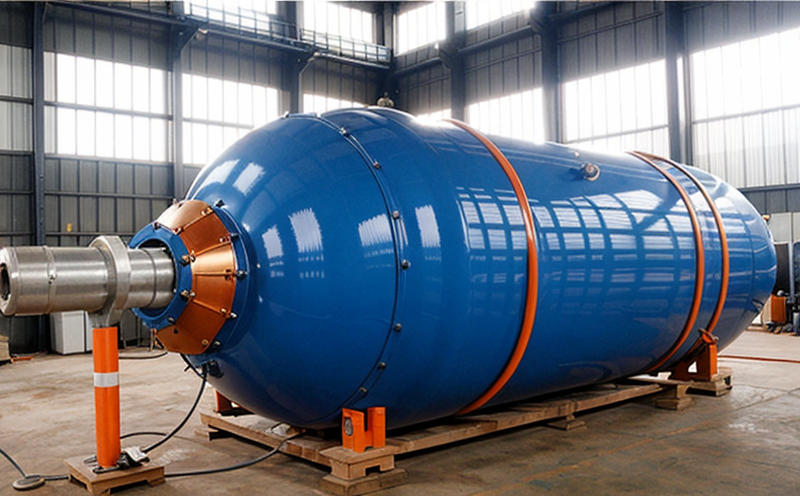Pressure vessel external coating inspection
The inspection of pressure vessel external coatings is a critical process that ensures the integrity and safety of these vessels during their operational lifecycle. Pressure vessels are designed to contain gases, liquids, or mixtures at pressures higher than those exerted by the atmosphere and temperatures above normal ambient conditions. The external coating serves as a protective barrier against environmental factors such as corrosion, abrasion, and microbial growth.
Given the hazardous nature of materials stored in pressure vessels, any breach in the integrity of the vessel or its coatings can lead to catastrophic failures. These failures can result in loss of life, property damage, and severe environmental contamination. Therefore, regular inspections are essential to maintain the operational safety and compliance with regulatory requirements.
The inspection process typically involves visual examination, ultrasonic testing, magnetic particle inspection, and radiography, among other methods. Each method serves a specific purpose depending on the material properties of the vessel and the type of coating used. For instance, ultrasonic testing can detect flaws within the coating or beneath it, while magnetic particle inspection is useful for identifying surface cracks and discontinuities.
Visual inspections are conducted to check for visible signs of damage such as cracks, peeling, or blistering. This method requires a trained inspector who can accurately interpret visual clues that may indicate potential issues with the coating. Ultrasonic testing uses high-frequency sound waves to generate images of internal structures and flaws within the coating.
The selection of appropriate inspection techniques is crucial for ensuring accurate results. Factors such as the type of material, thickness of the coating, and service environment must be considered when choosing the most effective method. For example, in environments exposed to severe weather conditions or aggressive chemicals, thicker coatings with enhanced protective properties may be necessary.
Compliance with international standards is paramount for ensuring consistent quality and safety across different regions. The American Society for Testing and Materials (ASTM) provides guidelines specifically tailored towards pressure vessel coating inspections. These include ASTM D6380-14 which covers procedures for evaluating the adhesion of coatings to metallic substrates using peel tests.
Regular monitoring through periodic inspections allows operators to detect early signs of degradation before they escalate into more serious problems requiring extensive repairs or replacements. By adhering strictly to recommended inspection schedules and employing advanced technologies, users can significantly extend the service life of their pressure vessels while minimizing maintenance costs.
Why It Matters
The importance of external coating inspections cannot be overstated given that these vessels operate under extreme conditions where even minor flaws could have devastating consequences. Properly applied and maintained coatings play a vital role in preventing corrosion, which is one of the leading causes of failure for pressure vessels.
- Enhanced Safety: Regular inspections help identify potential risks early on, allowing timely interventions to mitigate hazards before they become critical.
- Regulatory Compliance: Meeting stringent regulatory requirements ensures adherence to industry best practices and reduces the likelihood of penalties or fines.
- Economic Benefits: Preventive maintenance strategies not only enhance operational efficiency but also reduce downtime associated with unplanned repairs.
In summary, thorough inspections are indispensable for maintaining optimal performance levels while ensuring long-term reliability and sustainability of pressure vessels. This proactive approach contributes significantly towards creating a safer working environment and upholding high standards of quality control.
Scope and Methodology
The scope of external coating inspection encompasses various aspects including visual examination, non-destructive testing (NDT), and evaluation of adhesion strength. Visual inspections involve thorough examination using magnification tools to detect any visible signs indicative of deterioration or damage.
- Visual Inspection: This initial step involves detailed scrutiny for cracks, peeling, blisters, and other visible defects on the surface of the coating.
- Thickness Measurement: Using specialized equipment, precise measurements are taken to assess whether there has been thinning due to wear or erosion over time.
- Adhesion Strength Testing: Various methods may be employed here such as cross-cut tests where small cuts are made in the coating followed by peeling it back gently. The degree of separation provides insight into how well the coating adheres to underlying surfaces.
The methodology for NDT procedures can vary based on specific requirements but generally includes ultrasonic testing, radiography, and magnetic particle inspection as mentioned earlier. Each technique offers unique insights that complement each other in providing comprehensive assessments.
Accurate documentation is essential throughout this process to ensure transparency and traceability. Detailed records should include descriptions of observed findings along with photographs taken during inspections. These documents serve both internal purposes like quality assurance audits, as well as external requirements such as compliance reports submitted to regulatory bodies.
Competitive Advantage and Market Impact
- Innovation Leadership: By staying ahead in terms of technology adoption and best practices implementation, our services contribute significantly towards establishing a reputation for innovation within the industry. This positioning attracts leading companies seeking reliable partners.
- Cost Efficiency: Our comprehensive approach ensures that clients achieve maximum value from their investments by minimizing unnecessary expenses through effective planning and execution.
In today's competitive market, companies are increasingly looking at ways to differentiate themselves not only based on product quality but also service excellence. Our pressure vessel coating inspection services offer precisely this - a blend of cutting-edge technology and meticulous attention to detail that sets us apart from competitors.
The demand for safer and more efficient pressure vessels continues to grow as industries strive to enhance operational efficiency while reducing risk. With stringent regulations being imposed globally, there is an ever-increasing need for trusted service providers capable of delivering top-notch quality inspections. Our commitment to excellence in this area ensures that we meet these demands effectively.
Moreover, our expertise extends beyond merely performing inspections; it includes offering strategic advice aimed at preventing issues before they arise. This proactive stance helps businesses avoid costly downtime and potential disruptions in operations.





